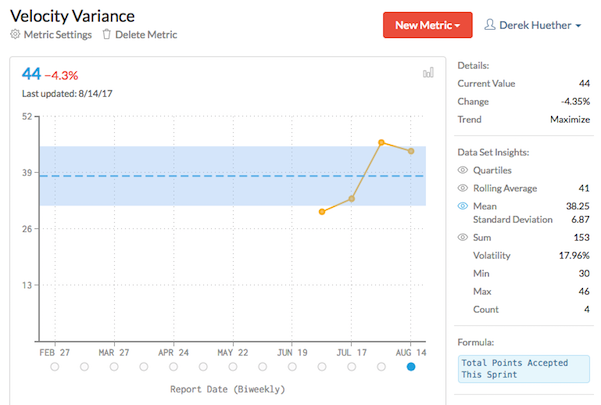As an executive, you will be faced with the choice to do the pivot (if you can) or persevere (if you have no other choice). This will lead to a series of “bets”. You lead with a hypothesis that the things you change will allow you to operate at pre-event levels. But, how long will it actually take for you to validate your hypothesis and have a bet pay off with pre-event levels? If you run out of time to figure it out or run out of bets you can place, then you either lose your standing in the market or worse risk going out of business.
How Atlassian Jira Align Supports Flow Metrics
I keep getting asked, does Jira Align support Flow Metrics, as defined in the Flow Framework and SAFe? The short answer is yes. If you believe these metrics will help unlock the potential of your teams, use this community post to see working examples of Tableau reports I have created using Jira Align and Enterprise Insights.
Buffer Fever Chart
Lack of Work Alignment Can Cost Millions
Metrics Cookbook available on Amazon
Why You Should Use Variance Instead of Velocity
Knowing your metrics
velocity variance
Know your metrics and the behaviors they drive
Everyone at your company should understand which metrics drive the business, and what behaviors they encourage. That's what Joe Nigro, CEO of energy company Constellation, said in a 2016 Harvard Business Review article. He went on to say, “Everyone needs to know how each metric fits into the big picture…why and how we’re measuring something, and how it’s relevant to performance.”
More directly, I would say metrics should capture the changing environment of your business so you can make informed decisions. But how do you know your metrics are any good?
Encouraging behaviors
If you ask your fellow employees which metrics drive the business, would they know? Would they care? I believe their jobs should depend on them caring, though measuring that would be difficult. If they are unwilling to do their part, perhaps they should "help" some other company. Everyone should be held personally accountable to understand what helps drive the business and how they can help. If they knew what the metrics are, how could it change their behavior (in a positive way)?
Metrics executives may be thinking about
From an executive level, I can only imagine every CEO (from Joe Nigro of Constellation to your own) start by thinking about these metrics:
Topline revenue - Money made from selling goods or services
Customer retention - Attracting the right customer, getting them to buy, buy again, buy in higher quantities or at higher rates.
Customer acquisition cost - The total cost associated with acquiring a new customer, including all aspects of marketing and sales.
Gross margin - Calculated as a company's total sales revenue minus its cost of goods sold, divided by the total sales revenue, expressed as a percentage.
Overhead costs - fixed costs that are not dependent on the level of goods or services produced by the business, such as salaries or rents being paid per month.
I hope executive management will help employees understand the metrics that drive the business and why they are important. I hope the employees will internalize these metrics and consider ways to help the company increase revenues, widen margins, or control costs.
One step deeper into the weeds
From a productivity level, be it manufacturing or software development, I think the staff (and the executives) need to understand (and improve) the system of delivery. To this, if executive management doesn't know these productivity numbers, then how can they know when they are making unreasonable requests of the system? A system of delivery in a black box and executives in an ivory tower are not a good combination. A dissatisfied staff can put your company at serious risk, while on the other hand, a satisfied and productive staff can help drive the business.
Cycle time - The total time from the beginning to the end of your process.
Lead time - Starts when a request is made and ends at delivery.
Utilization - 100% being the maximum, it's the act of making practical and effective use of people or things
Throughput - The amount of material or items passing through a system or process. What did you get done or delivered?
Cost of Delay - The means to calculate and compare the cost of not completing something now, by choosing to do it later.
I hope everyone will think of ways to shortening cycle and lead times while maintaining or increasing throughput. If maximum utilization is how you make the greatest topline revenue, how do you reach that utilization level without breaking your people or machinery?
Another step deeper into the weeds
From an individual level, I believe we are truly personally accountable. Let's ask the first two questions from this post again. Which metrics drive the business? What behaviors do they encourage?
Commitment/Completion Ratio - What have I personally committed to? Am I meeting that commitment?
Throughput (Velocity) Variance - Given the things that I've recently completed, am I predictable? Can others make commitments, based on what I do?
Confidence Score - How confident am I that I will actually keep the commitment I made?
I hope individuals will be honest about what they think they can do in a given period of time. I hope they will be honest with their coworkers and with management if they don't think they can keep a commitment.
What behaviors do you think metrics encourage?
Image Source: Calculated Velocity Variance via Notion [UseNotion.com]

